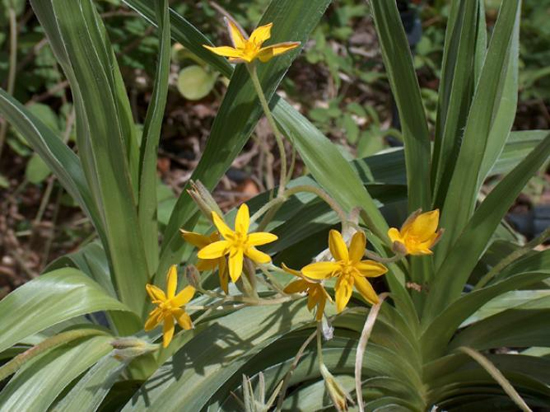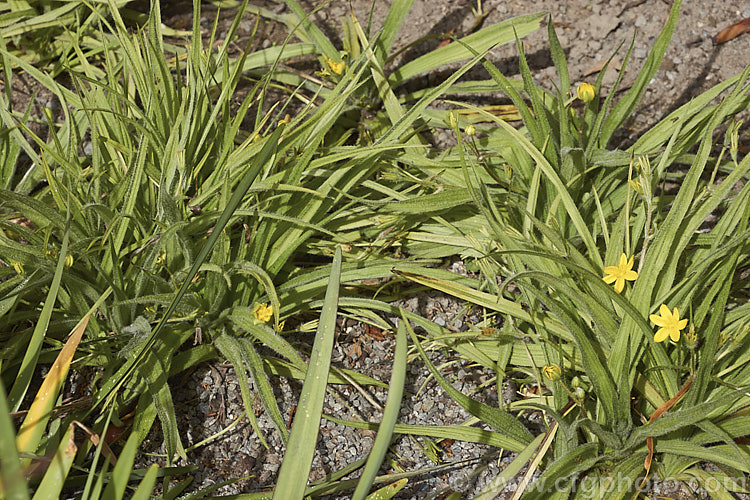Latin name: Hypoxis rooperi
Synonym: Hypoxis hemerocallidea
Other names: Bantu Tulip, Sterretjie
Habitat: Hypoxis rooperi is indigenous to South Africa.
Description of African Potato
Flower and Fruit: Four to 10 flowers are arranged in racemes on a long peduncle; the pedicles are 1.2 to 2.5 cm long. The 6 tepals are approximately 18 mm long, elongate, free and yellow. There are 6 stamens, and the ovary is inferior, 3-chambered, top-shaped and thickly pubescent.
The fruit is a densely pubescent capsule approximately 12 mm long and split in the middle. The seeds are black and warty.
Leaves, Stem and Root: The plant is a herbaceous perennial with 12 to 18 leaves that are 30 to 60 cm long, 2.4 to 4 cm wide, lanceolate, acuminate, firm with a ciliate margin and short hairs underneath. The leaves grow from a globose shoot, which has a diameter of 5 to 8 cm and is crowned with a ring of bristle-like hairs.

Constituents of African Potato
Lignans (3.5 to 4.5%): particularly hypoxoside (norlignan glucoside)
Steroids: sterols, including beta-sitosterol (ca. 0.2%), beta-sitosterol glucoside
Polysaccharides: starch
Effects
The phytosterols, which have not as yet been more closely identified (beta-sitosterol is possibly the chief active ingredient), are said to have anti-exudative effects in animal experiments. The positive effect of the African potato on benign prostate hyperplasia (reduction of the residual urine volume, increase of the uroflow, improvement of subjectively experienced complaints) is explained by the phytosterols’ inhibition of local prostaglandin synthase.
Indictations and Usage
Traditionally used internally for micturition complaints resulting from benign prostate hyperplasia, cystitis (South Africa/decoction) and lung disease (Botswana). It is used externally as a vulnerary (Africa).
Production
Bantu tulip is the fresh or dried rhizome tuber of Hypoxis rooperi. The plant is collected in the wild, cut and then dried in the sun.
Precautions and Adverse Reactions
No health hazards are known in conjunction with the proper administration of designated therapeutic dosages.
Medicinal Parts Used
The medicinal part is the plant’s rhizome tuber.
Dose
For one HIV study the recommended dose of African potato was 15 mg/kg/daily of hypoxoside; four capsules of African potato as a dose per day.
RESEARCH PAPER: ‘African Potato’ (Hypoxis hemerocallidea corm): A Plant-Medicine for Modern and 21st Century Diseases of Mankind? – A Review
APotato.-2-7Co-administration of a commonly used Zimbabwean herbal treatment (African potato) does not alter the pharmacokinetics of lopinavir/ritonavir
Co-administration of a commonly used Zimbabwean herbal treatment (African potato) does not alter the pharmacokinetics of lopinavir/ritonavirReferences
Brauer H, Schomann C, Tolerance of beta-sitosterin from Hypoxis rooperi in patients with limited liver function. Results of a controlled double-blind study, Fortschr Med, 96:833-4, 1978 Apr 20.
Hansel R, Keller K, Rimpler H, Schneider G (Ed.), Hagers Handbuch der Pharmazeutischen Praxis, 5. AufL, Bde 4 – 6 (Drogen), Springer Verlag Berlin, Heidelberg, New York, 1992-1994.
This article is copyrighted by Ital is Vital, 2025. Want to re-post this article? Visit our guidelines.
DISCLAIMER: THIS WEBSITE DOES NOT PROVIDE MEDICAL ADVICE
The information, including but not limited to, text, graphics, images and other material contained on this website are for informational purposes only. The purpose of this website is to promote broad consumer understanding and knowledge of various health topics. It is not intended to be a substitute for professional medical advice, diagnosis or treatment. Always seek the advice of your physician or other qualified health care provider with any questions you may have regarding a medical condition or treatment and before undertaking a new health care regimen, and never disregard professional medical advice or delay in seeking it because of something you have read on this website.
